When the Ford F-150 Raptor first debuted back in 2010, it was a serious tour de force for Ford; massive
V8 options with the 6.2L V8, rear-wheel drive, and a
fully off-road built suspension, the Raptor was the
absolute best off-road truck on the market in terms of performance and drivability. These trucks were
more capable and faster off of pavement than any vehicle designed for road use before, and as a result,
created the legendary “Raptor” name for the Ford lineup. As years passed, the Raptor became better and
better regarding performance by leaving the massive V8 and moving to a 411 horsepower twin-turbo V6 and
eventually a 450 horsepower variant of the same motor by 2020. By 2021, the Raptor had cemented itself as parts of the F-150 lineup as well as in the Ranger lineup
overseas and had even spurred on rivals. The main competition, the Ram TRX, boasted a massive 702
horsepower but still was bested by the Raptor in terms of off-road performance. The F-150 Raptor remains
nearly unrivaled, but going into the 2023 model year it faces its biggest threat yet and it comes from
within Ford themselves. This rival comes from Ford’s true off-road machine - the Bronco Raptor - which
takes performance and inspiration from the Ultra4 Bronco DR race truck. The Bronco, while fresh to the market, defined Ford’s off-road market until the 1990s, is back and
kicking with its sights set on vehicles like the Wrangler, Tacoma TRD Pro, and with the Raptor trim
level the F-150 Raptor. These two titans of off-road performance are more than likely going to overlap
in buyers, performance, and pricing as they sit currently. Each vehicle has its own strengths against
the other as well as weaknesses that go further than skin deep - even without a comprehensive test of
the Bronco Raptor’s performance being available yet.
Power
Suspension
Usability
Performance
Table
The F-150 Raptor has a serious advantage in terms of reputation over the Bronco. While the Bronco may
have been the king of Ford off-road at one point, the Raptor has been the top off-road vehicle since
2010 and the 3rd generation of the truck is ready to fight tooth and nail to hold its place on the
mountain. The F-150 Raptor features a 3.5 liter twin-turbo V6 still at 450 horsepower and 510 lb-ft of
torque which puts it slightly higher than the Bronco Raptor’s assumed horsepower and torque ratings,
however, the F-150 is a larger vehicle so these increases may not equal actual higher performance. The
F-150 also is able to use its heft to its advantage when accelerating by helping put the power down
which results in a 5.1 second 0-60 time. The Bronco Raptor receives a motor not available in the F-150 Raptor or even in any other Bronco trim
level. Borrowing the 3.0 liter twin-turbocharged V6 from the Explorer ST, the Braptor as many call it is
promised to crank out at least 400 horsepower and upwards of 415 lb-ft of torque which should still give
it a sub-6 second 0-60 time. The Braptor is not designed to be the fastest vehicle on the road,
rather
it is designed to be one of - if not the most competent road-legal vehicles off of pavement.
Additionally, the Braptor takes the 10R60 gearbox from the F-150 Raptor for its own use, using
a
well-tested gearbox for serious off-road use. The F-150 Raptor has always had serious performance suspension similar to what is found on trophy trucks.
With a first-ever five-link suspension which is designed to emphasize ground clearance and
maneuverability, the F-150 Raptor fits 37-inch tires in the wheel wells, making it the most intricate
suspension of any light-duty truck on the market. Five-link suspension paired to the Raptor-exclusive
Fox Racing shocks and dampers with active valving to improve their performance. When the 2nd generation
Raptor debuted, it had the highest strength half shafts on the market. The goal of the Raptor is to make
it the most off-road capable pickup on the market, and with each passing generation, it gets even more
capable. While the F-150 Raptor has set the standard for off-road suspension, the Bronco Raptor might even surpass
that. The Bronco received custom-built Fox Racing shocks as well and built off of Ford’s new
High-Performance Off-Road Stability Suspension (HOSS 4.0) to make it even more capable. Returning to
solid axles over the independent suspension in other Broncos, the Raptor also gained more structural
rigidity to counter the convertible design’s weak points. New tie rods and control mounts have been
installed as well, connecting and disconnecting at differing speeds.
When it comes to usability, these two vehicles may seem like a poor match, but they are both surprisingly
usable. The F-150 has a very obvious advantage in some aspects. The F-150 Raptor reaches a length of
243.5” or around 20 feet long with the pickup bed which makes it hold a large footprint across the sand
and mud it is driven through. While this is a large truck with a full-sized interior via the SuperCrew
body style being the only available option, the 5.5-footbed is smaller than many people would use if the
truck was intended to solely be a work vehicle. While the interior space is good in the Raptor F-150,
the usable carrying space is less than some would want from a truck. While the dimensions of the Raptor F-150 may work better for a truck, the Bronco Raptor uses its smaller
size more efficiently. Coming in at 191 inches or around 16 feet, it is much smaller and more
maneuverable than its F-150 sibling. With the Bronco Raptor sharing its initial platform with the
smaller Ranger, this makes sense. However, since the Bronco is not a pickup truck, all of the vehicle’s
length can be used as interior space while still providing over 37 cubic feet of cargo space. While this
is less than the F-150, it is a better-packaged space and offers more versatility. While many people may confuse power for performance, they are very much not the same, especially when it
comes to vehicles such as this. Vehicles such as the Raptors, while horsepower is important, are mainly
in their suspension and torque to dig in on rough or soft terrain to rip over it with ease. These two
vehicles share quite a lot of their suspension
components, as well as their gearboxes with the Bronco
drawing heavily on the F-150 Raptor’s past. While the F-150 has better current stats, actual off-road
performance will be determined off the beaten path. The Bronco Raptor does have some advantages over the F-150 Raptor in the sense of size and weight
distribution since it is four feet shorter than the F-150 and is better situated in its overhangs.
Although it is 50 horsepower lower, the suspension and dimensions are better set up for serious off-road
driving than the F-150, even at a few hundred pounds heavier. The F-150 Raptor, with its pickup bed, has
a larger rear overhang which is not beneficial in departure angle. However, the F-150 is better suited
for climbing through rough terrain with its weight distribution spread across the vehicle. The Bronco
Raptor, while set up for the same environment, is just one step further towards full off-road Baja truck
and has more suspension travel. Image Credit: Ford Media and MotorTrendRaptor Battle: F-150 vs. Bronco
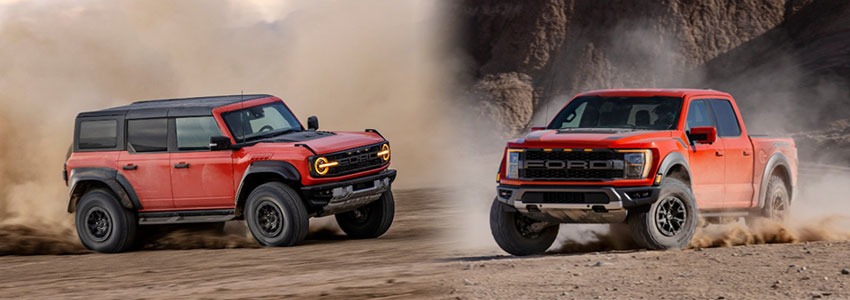
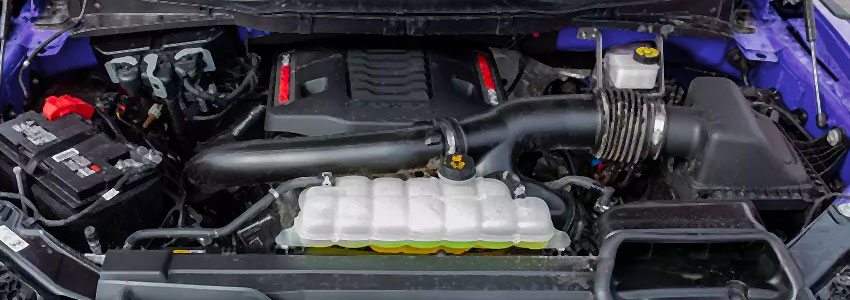
Bronco Raptor vs F-150 Raptor: Power

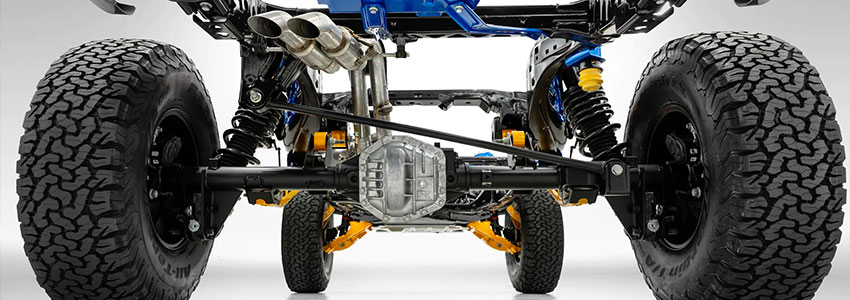
Bronco Raptor vs F-150 Raptor: Suspension

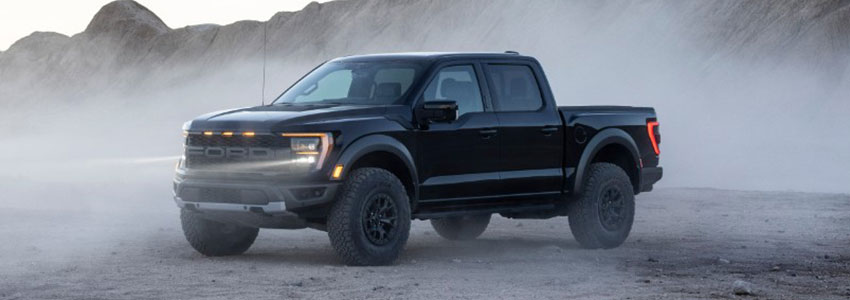
Bronco Raptor vs F-150 Raptor: Usability
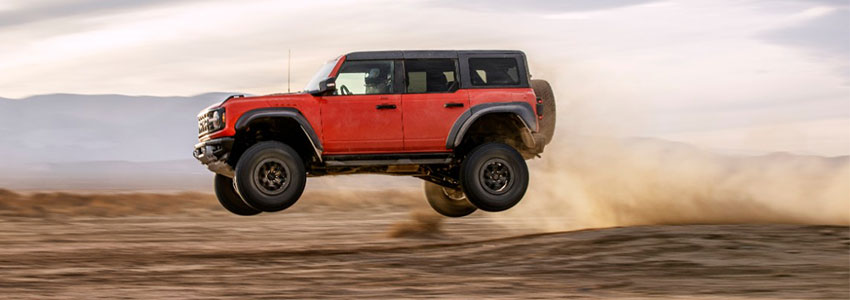
Bronco Raptor vs F-150 Raptor: Performance
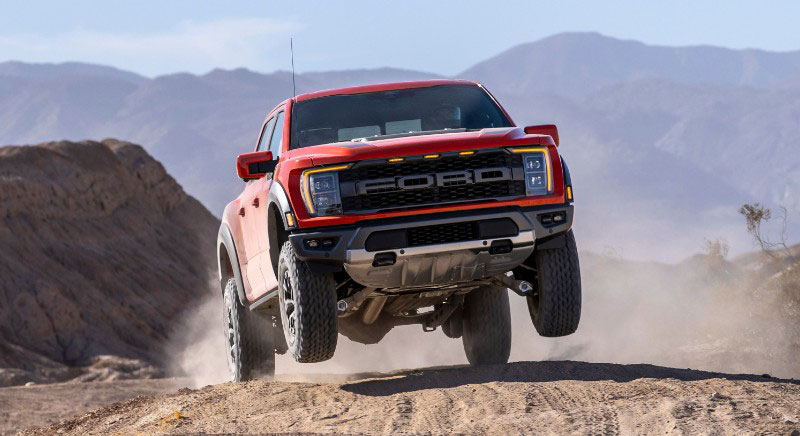
Bronco Raptor vs F-150 Raptor: Stats
Bronco Raptor
F-150 Raptor
Engine
Twin Turbo 3.0L V6
Twin Turbo 3.5L V6
Horsepower
~400
450
Torque
~400
510
Ground Clearance
13.1 inches
13.1 inches
0-60
TBA
5.1 seconds
Price
$71,490
$68,675
Transmission
10R60
10R60
Compression Ratio
10.5:1
10.5:1
Suspension
FOX Racing Shox HOSS System
FOX Racing Shox HOSS System
Wheelbase
116.5 inches
145.4 inches
Approach Angle
47.2
33.1
Width
86.9 inches
86.6 inches
Weight
5,733
5,684
Payload
1,100lbs
1,400lbs
Related Articles




